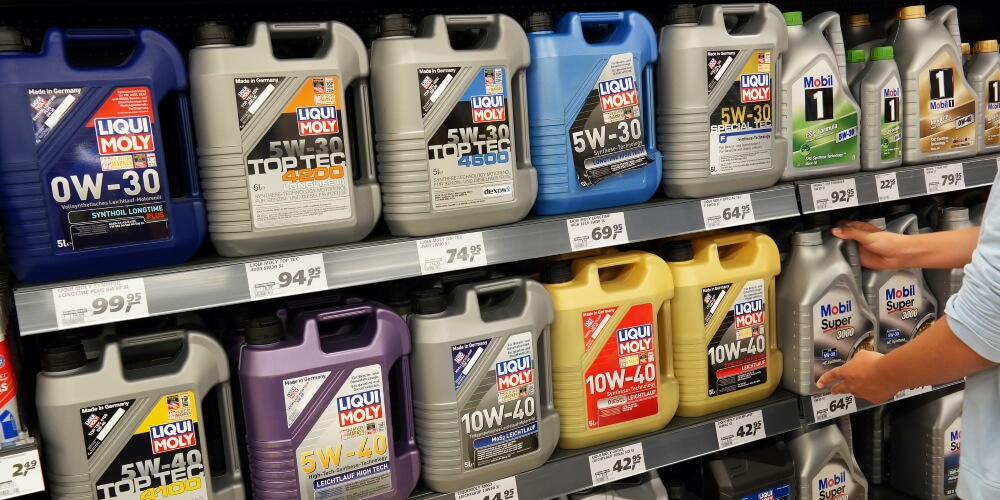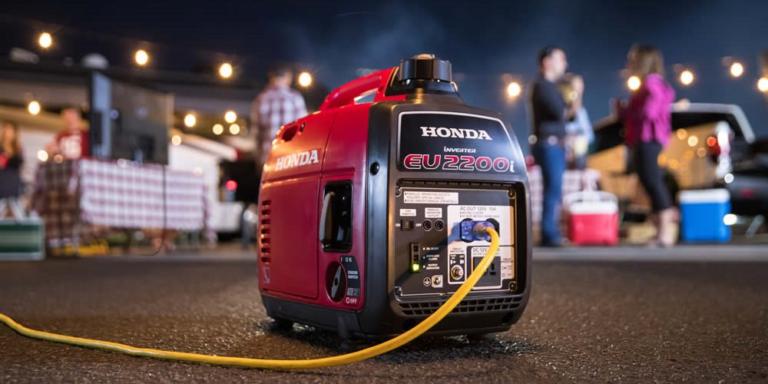For those that are not mechanically-minded, basic car maintenance (and generator maintenance as well) can sometimes be a significant source of stress. Cars are expensive pieces of machinery, and we all understand the importance of keeping them running smoothly for a long time.
But somehow we’re expected to change oil and gas, diagnose faults, and even blow up our own tires! Filling up gas is easy enough, but oil can get confusing.
Not only do you have to figure out how to open up the bonnet and use the dipstick, but you also need to effectively choose the right type of oil to put in!
Don’t worry. Our team here at Generatorist has helped over 600,000 visitors find information about generators & engines and we will help you as well!
In this post, we’re going to examine two extremely common types of engine oil: 5W-20 vs 5W-30. Both types of oil can be used in cars and generators as well.
The main difference & quick comparison:
The 5W20 oil & its benefits
The 5W20 oil – This oil is really “fluid” at lower temperatures, making the process of starting your cold engine much easier. It is recommended for use at -31°F up to 77°F / -35°C up to +25°C (outside temperature).
It’s more fuel-efficient, it’s thinner, flows faster with less friction and is more suitable for colder climates. It breaks down quicker in hotter climates than the 5W30 oil. It is much more preferable in winter. Here are the top rated 5W-20 Oils on Amazon.
The 5W30 oil & its benefits
The 5W30 oil – This oil has the same viscosity at lower temperatures. However, it is a little bit thicker at higher temperatures than 5W20. It is recommended for use at -31°F up to 95°F / -35°C up to +35°C (outside temperature).
It’s thicker, less fuel-efficient and more suitable for warmer climates. This oil makes the engine start slower in colder climates. It gives better protection in the long run than the 5W20 oil. Here are the top rated 5W-30 Oils on Amazon.
One question a lot of people have about the 5W20 oil and the 5W30 oil is whether they can be mixed.
The answer is that yes, they can indeed be mixed, though this shouldn’t be your preferred strategy, as you will be left with some of the downsides of both types of oil. You just can’t expect great results when you mix different viscosity grade oils.
In this guide we’ll help you to make the right choice for your car and generator as well. And in doing so, you should gain a better understanding of the main differences and even how oil is graded. Let’s begin.
5W20 vs 5W30
5
The first sequence of numbers (before W) refers to the viscosity of the oil at low temperatures.
W
The letter W refers to the word “winter” & is used to differentiate the oil’s viscosity at cold & hot temperatures.
20
The second sequence of numbers (after W) refers to the viscosity of the oil at high temperatures (212°F / 100°C).
First: you may be wondering what the difference between these two types of oil is. What do these numbers mean, and what do they tell you about the type of oil you’re choosing?
Essentially, all this grading system tells you about is the viscosity of your oil. Here, a lower number denotes a lower amount of viscosity, while a higher number represents a higher amount!
Viscosity is thickness and stickiness.
An example of a viscous liquid is honey, for instance, whereas water has a very low viscosity. The faster a liquid pours then, the lower its viscosity.
The reason you have two numbers is that the chemical properties of oil alter depending on temperature. When it is cold, oil is typically less viscous. It then thickens up when it gets hot.
This is important, seeing as your car (or your generator) may well be sitting outside for long periods when it’s cold outside. At the same time, though, when an engine runs, it gets very hot and thereby heats up the oil in the engine.
The first number then is the viscosity when it is cold – during winter, or when the car isn’t moving. In fact, the “W” stands for winter.
Both these types of oil, therefore, have a low viscosity during winter and when not in use. That’s because both types of oil are 5W, rather than 10W or 15W – both of which also exist.
(FYI, here are the best 5W20 oils and the best 5W30 oils on the market, in case you are looking for one right now)
5W is a good starting point when choosing an oil, as it means the oil will be runny when the engine starts, helping it to move more quickly through the system.
Moreover, it also means that the oil will be able to withstand cold temperatures better than a 10W or 15W oil. Those latter types are generally only suitable for warmer climates.
Here is a great resource about SAE Viscosity Grades for engine and gear oils according to the SAE standards J300 and J306. Check it out to discover the measurement data of engine oils over a wide temperature range.
The second number is what we’re interested in.
This tells you the viscosity of the oil under operating temperatures. So when the engine is running, and the oil heats up, a 5W30 oil will get much thicker than a 5W20 oil.
Why Viscosity is Important
If a runny oil travels more quickly to the engine, why would you choose a thicker oil at all? The answer is that once inside the engine, the thicker oil is better able to do its job.
The purpose of oil is to coat the surfaces of the different components in an engine.
By doing this, those components won’t be able to come into direct contact. This allows them to glide over each other, due to the well-lubricated surfaces.
In contrast, if the oil were not there, then the metal surfaces would grind against one another, which would lead to a more rapid breakdown and degradation of the metal.
This is how a higher quality oil – and particularly a thicker oil – can help to maintain the performance of your engine for longer.
If your oil is very runny, then it may even get thrown off of the mechanical parts as they move. This can leave those parts virtually naked, and thereby more likely to get damaged.
Another consideration is that a very runny oil will leak more quickly if there is any damage to the engine.
If you do have a minor oil leak, switching to a slightly higher grade of oil can be enough to stop the leak in some cases!
The recommended oil type for your generator:
According to the experts from Generac, you should keep these recommendations in mind when buying oil for your generator:
Above 32°F (0°C), use SAE 30. Below 40°F (4.4°C) and down to -10°F (-23°C), use 10W-30. Synthetic 5W-30 can be used in all temperatures. Oil should be changed after the first 20-30 hours of operation and every 100 hours of run time thereafter.
Just remember: Always use the weight of oil that is recommended, and you will have a few issues.
Choosing The Best Oil For Your Generator?
Which is Right for You?
As mentioned, runnier oil will move more quickly when it is cool. This can additionally mean that it moves more easily inside the engine once heated up.
However, in very high temperatures, thinner oils can break down more quickly.
You may be wondering where oil goes when you run your car! While some will get thrown from the vehicle, a lot of it will remain in the engine but can break down to form a kind of thick sludge.
With proper maintenance, you can keep this at bay and ensure your car and generator has a long and happy life – but there is no way to entirely prevent that sludge build up.
It’s for this reason, that you may choose a higher grade of oil during hotter climates.
Moreover, some types of engines will prefer a thicker type of oil which provides more protection. This, combined with greater chemical stability, means that 5W30 is the slightly more widely used oil of the two.
To break it down then:
- Use 5W30 in warmer climates
- Use 5W20 in cooler climates
- Most people will fall into the first category
The One Simple Rule
With that said though, there is one straightforward way to make this decision much easier: follow the manufacturer’s guidelines.
You’ll find that when you take a look in the manual that came with your vehicle or generator, it will tell you the ideal oil to use, and a range of oils that you can choose from.
Not only that, but it may well let you know whether to change your oil type in particular weather conditions. In case you need some help with the process, here is our guide to changing the oil in your generator.
This makes it very clear which oil you should use, and that in turn will guarantee that your vehicle enjoys the best economy, while also protecting the engine, so it runs better, for longer.
If in doubt, just follow the instructions that came with your car or generator! It’s easy!
Can you mix these
One question a lot of people have about 5W20 and 5W30 oil is whether they can be mixed. The answer is that they can indeed be mixed, though this shouldn’t be your preferred strategy.
When you mix 5W20 and 5W30, you will be left with some of the downsides of both types of oil.
That is to say that the oil you’re left with could still be quicker to freeze, while also breaking down in warm temperatures.
But with that said, the difference is not great enough for this to be an issue in most cases – as long as your vehicle will accept both types.
This certainly won’t be an issue if you are forced to change oil and you have to switch to a different type – they will mix, and no harm will be done!
According to car experts from TiresPlus.com, it’s OK to mix synthetic oil with regular oil as well:
“Since motor oils are generally made from the same ingredients (base oil and additives), they are typically compatible when mixed. The American Petroleum Industry actually requires that all motor oil made in the U.S. be compatible with one another.”
Mineral vs Synthetic Oil
Another decision you need to make when choosing either type of oil is whether you want to use synthetic or mineral. Mineral oil is also called “regular” oil, seeing as it is made from natural resources just like oil has been for the longest time.
Synthetic oil is slightly newer.
This is an artificially created (synthesized) oil that has been designed to offer more benefits to the driver. In some cases, the synthetic oil started as a mineral oil but had additional ingredients added in.
In other cases, the oil is entirely artificial. The additives included in synthetic oil have a number of different jobs.
They help to slow the breakdown of your oil, they help to coat the mechanical parts better, and they may even be able to plug a leak.
HERE ARE THE BENEFITS OF SYNTHETIC OILS:
- Superior performance in extreme temperatures
- Longer service life & extended oil change intervals
- Better resistance to oxidation, thickening, and deposits
- Improved wear protection for engine components
- Higher resistance to thermal and oxidative breakdown
- Improved fuel economy & reduced emissions
(You can read more about the benefits of synthetic oil in this article on IDriveSafely.com and in this informative comparison on Valvoline.com)
Generally, synthetic oil is, therefore, better for your car AND lasts much longer. Whereas a refill of regular oil might be good for 200-500 miles, a synthetic oil change could last you 700 miles up to 1,500 miles!
This means that you will get your money back in the long term.
SYNTHETIC OIL AND YOUR GENERATOR:
Using synthetic oil is safe for your generator. In the past, there were some issues with overheating in small engines when they were first introduced. Nowadays they are completely safe.
For example, the most popular manufacturer of generators – Honda, offers this advice:
“Honda engines are developed, tested and certified with petroleum based motor oils as a lubricant. Synthetic oils may be used; however, any motor oil used in our engines must meet all oil requirements as stated in the owner’s manual.
In addition, recommended oil change intervals must be followed.”
Conclusion: Don’t Fret
While there may be a lot of different factors to consider when choosing an oil, the simplest instruction is just to follow the guidelines in your manual.
They are there for a reason, and this will ensure you get the most efficient oil that protects your car or generator in the long term.
But with that said, if you use the “wrong” type of oil, this won’t normally be a problem unless you live in extreme weather conditions. Mixing oils isn’t a big deal either.
Let’s sum up the difference once again:
The 5W20 oil & its benefits
The 5W20 oil – This oil is really “fluid” at lower temperatures, making the process of starting your cold engine much easier. It is recommended for use at -31°F up to 77°F / -35°C up to +25°C (outside temperature).
It’s more fuel-efficient, it’s thinner, flows faster with less friction and is more suitable for colder climates. It breaks down quicker in hotter climates than the 5W30 oil. It is much more preferable in winter. Here are the top rated 5W-20 Oils on Amazon.
The 5W30 oil & its benefits
The 5W30 oil – This oil has the same viscosity at lower temperatures. However, it is a little bit thicker at higher temperatures than 5W20. It is recommended for use at -31°F up to 95°F / -35°C up to +35°C (outside temperature).
It’s thicker, less fuel-efficient and more suitable for warmer climates. This oil makes the engine start slower in colder climates. It gives better protection in the long run than the 5W20 oil. Here are the top rated 5W-30 Oils on Amazon.
Hopefully though, understanding the differences between these types of oil has helped you better understand your choices, and thereby buy with more confidence and awareness in the future.
Further resources:
- Choosing the Best Oil for Your Generator
- 5W30 vs 10W30 Oil: What’s the Difference?
- SAE 30 vs 10W30: Which Oil Should You Use in Your Lawnmower or Generator?
- Oil Viscosity Explained: 5W20 vs 5W30 vs 10W30
- How to Change Oil in a Generator
- 5W20 Oil vs 5W30 Oil – Everything You Need to Know
- Choosing the Best Generator for Your Household
- The Best Motor Oil in Every Category
- Top 10 Best Synthetic Oil Products You Can Buy
About Generatorist

Matthew Gerther
Founder, Generator enthusiast
Our aim here at the Generatorist is to become the No. 1 resource for all things related to generators & your power needs. We have helped over 600,000 visitors with our tips, articles and reviews and we will help you as well.
Our work has been featured in many publications around the world – Yahoo.com, Telegram.com, PaylessPower.com, PopSci.com, TopTenReviews.com, TechRepublic.com, iRV2.com, ThePrepared.com, Renogy.com or ADT Solar. Generators are our passion, and we strive to provide the most reliable & most comprehensive information out there.











4 thoughts on “5W20 vs 5W30 Oil: What’s the Difference? Shopping Guide & Tips”
5w-20 and 0w-20 are actually only for temperatures below 60 degrees
Using them above that WILL cause oil burning and engine damage
Motor oil is classified as 5w20 or 5w30 by its viscosity, or what it’s like at higher temperatures and viscosity. … So owing to the viscosity, 5w20 is thinner at operating temperatures, while 5w30 is thicker at operating temperatures.
As mentioned, easiest is to just follow manufacturers instruction on which oil to use as they probably know best. Just work within the parameters of the owners manual recommendation shouldnt go wrong.
Hi. Your diagram explaining what 5w20 is not completely accurate.
5W20 VS 5W30
WHAT DO THE NUMBERS MEAN?
You say the 5 is the viscosity at cold temperatures <- OK
You say the 20 is the viscosity at warm temperatures. < – NOT OK
This would imply that the viscosity increases as temperature increases – which is definitely not correct.
The 20 actually means that the oil flows like a SAE 20 weight oil flows at 100 degrees C.
The viscosity DECREASES as temperature INCREASES.
Do you see the difference?
Thanks.